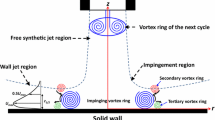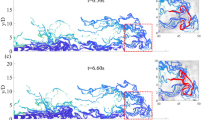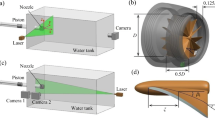Abstract
Two-dimensional particle image velocimetry (PIV) is used to investigate the influence of the orifice-to-wall distance on synthetic jet vortex rings impinging on a fixed wall. Both evolutions of vortical structures and statistical characteristics of flow fields at different orifice-to-wall distances are presented. It is found that different orifice-to-wall distances have different effects in terms of the vortex strength and impinging speed when the vortex rings are approaching the wall. The secondary vortex ring can be observed within the shear layer only when the dimensionless orifice-to-wall distance is close to or less than the dimensionless stroke length. Consequently, an appropriate orifice-to-wall distance plays a vital role in the sense of impingement effect. The statistical analysis of the flow field indicates that a wall jet forms after impingement, while both the decay rate of the maximum radial velocity and the spreading rate of the half-width decrease with the increasing orifice-to-wall distance. The non-dimensional wall jet velocity profiles at different orifice-to-wall distances all exhibit self-similar behaviors, which is consistent with the theoretical solution of the laminar wall jet.
Similar content being viewed by others
References
Smith B L, Glezer A. The formation and evolution of synthetic jets. Phys Fluids, 1998, 10: 2281–2297
Wang J J, Shan R Q, Zhang C, et al. Experimental investigation of a novel two-dimensional synthetic jet. Eur J Mech B-Fluids, 2010, 29: 342–350
Shuster J M, Smith D R. Experimental study of the formation and scaling of a round synthetic jet. Phys Fluids, 2007, 19: 045109
Shan R Q, Wang J J. Experimental studies of the influence of parameters on axisymmetric synthetic jet. Sensor Actuat A-Phys, 2010, 157: 107–112
Hao L S, Qiao Z D. Maximizing the effect of synthetic jet on airfoil separation flow control (in Chinese). J Northwest Polytech Univ, 2006, 24: 528–531
Wang J J, Feng L H, Xu C J. Experimental investigations on separation control and flow structure around a circular cylinder with synthetic jet. Sci China Ser E-Tech Sci, 2007, 50: 550–559
Feng L H, Wang J J. Circular cylinder vortex-synchronization control with a synthetic jet positioned at the rear stagnation point. J Fluid Mech, 2010, 662: 232–259
Feng L H, Wang J J. Synthetic jet control of separation in the flow over a circular cylinder. Exp Fluids, 2012, 53: 467–480
Feng L H, Wang J J, Pan C. Effect of novel synthetic jet on wake vortex shedding modes of a circular cylinder. J Fluids Struct, 2010, 26: 900–917
Feng L H, Wang J J, Pan C. Proper orthogonal decomposition analysis of vortex dynamics of a circular cylinder under synthetic jet control. Phys Fluids, 2011, 23: 014106
Ma L Q, Feng L H. Experimental investigation on control of vortex shedding mode of a circular cylinder using synthetic jets placed at stagnation points. Sci China Tech Sci, 2013, 56: 158–170
Cheng Z J, Ba Y L, Wang J J. Numerical investigation on separation control for flow over a bump with synthetic jet (in Chinese). J Beijing Univ Aeron Astron, 2012, 38: 886–890
Chen Z J, Wang J J. Numerical investigation on synthetic jet flow control inside an S-inlet duct. Sci China Tech Sci, 2012, 55: 2578–2584
Wang D Q, Xia Z X, Luo Z B. Study on low speed primary jet vector controlled by synthetic jet actuator with an inclination angle (in Chinese). J Solid Rocket Tech, 2004, 27: 165–172
Luo Z B, Xia Z X, Hu J X, et al. Numerical simulation and mechanism investigation on equidirectional fuel-air/oxygen mixing enhanced by synthetic jet actuators (in Chinese). J Solid Rocket Tech, 2004, 27: 267–271
Wang L, Luo Z B, Xia Z X, et al. Review of actuators for high speed active flow control. Sci China Tech Sci, 2012, 55: 2225–2240
Zhou Y, Bai H L. Recent advances in active control of turbulent boundary layers. Sci China Phys Mech Astron, 2011, 54: 1289–1295
Glezer A, Amitay M. Synthetic jets. Annu Rev Fluid Mech, 2002, 34: 503–529
Luo Z B, Xia Z X. Advanced in synthetic jet technology and applications in flow control (in Chinese). Adv Mech, 2005, 35: 221–234
Zhang P F, Wang J J, Feng L H. Review of zero-net-mass-flux jet and its application in separation flow control. Sci China Ser E-Tech Sci, 2008, 51: 1315–1344
Pavlova A, Amitay M. Electronic cooling using synthetic jet impingement. J Heat Trans-TASME, 2006, 128: 897–907
Ge M W, Xu C X, Cui G X. Transient response of Reynolds stress transport to opposition control in turbulent channel flow. Sci China Phys Mech Astron, 2011, 54: 320–328
Chen L, Tang D B, Lu P, et al. Evolution of the vortex structures and turbulent spots at the late-stage of transitional boundary layers. Sci China Phys Mech Astron, 2011, 54: 986–990
Jia Y X, Tang Z Q, Jiang N. Experimental investigation of Reynolds stress complex eddy viscosity model for coherent structure dynamics. Sci China Phys Mech Astron, 2011, 54: 1319–1327
Cai W H, Li F C. Analysis of coherent structures in drag-reducing polymer solution flow based on proper orthogonal decomposition. Sci China Phys Mech Astron, 2012, 55: 854–860
Kataoka K, Suguro M, Degawa H, et al. The effect of surface renewal due to large-scale eddies on jet impingement heat transfer. Int J Heat Mass Tran, 1987, 30: 559–567
Chu C C, Wang C T, Hsieh C S. An experimental investigation of vortex motions near surfaces. Phys Fluids, 1993, A5: 662–676
Cheng M, Lou J, Luo L S. Numerical study of a vortex ring impacting a flat wall. J Fluid Mech, 2010, 660: 430–455
Arévalo G, Hernández R H, Nicot C, et al. Particle image velocimetry measurements of vortex rings head-on collision with a heated vertical plate. Phys Fluids, 2010, 22: 053604
EI Hassan M, Assoum H H, Sobolik V, et al. Experimental investigation of the wall shear stress and the vortex dynamics in a circular impinging jet. Exp Fluids, 2012, 52: 1475–1489
Krishnan G, Mohseni K. An experimental study of a radial wall jet formed by the normal impingement of a round synthetic jet. Eur J Mech B-Fluids, 2010, 29: 269–277
Xu Y, Feng L H, Wang J J. Experimental investigation of a synthetic jet impinging on a fixed wall. Exp Fluids, 2013, 54: 1512
Zhou J, Adrian R J, Balachandar S, et al. Mechanisms for generating coherent packets of hairpin vortices in channel flow. J Fluid Mech, 1999, 387: 353–396
Wu Y, Christensen K T. Population trends of spanwise vortices in wall turbulence. J Fluid Mech, 2006, 568: 55–76
Pan C, Wang H P, Wang J J. Phase identification of quasi-periodic flow measured by particle image velocimetry with a low sampling rate. Meas Sci Technol, 2013, 24: 055305
Walker J D A, Smith C R, Cerra A W, et al. Impact of a vortex ring on a wall. J Fluid Mech, 1987, 181: 99–140
Lim T T, Nickels T B, Chong M S. A note on the cause of rebound in the head-on collision of a vortex ring with a wall. Exp Fluids, 1991, 12: 41–48
Couch L D, Krueger P S. Experimental investigation of vortex rings impinging on inclined surfaces. Exp Fluids, 2011, 51: 1123–1138
Dabiri J O. Optimal vortex formation as a unifying principle in biological propulsion. Annu Rev Fluid Mech, 2009, 41: 17–33
Gharib M, Rambod E, Shariff K. A universal time scale for vortex ring formation. J Fluid Mech, 1998, 360: 121–140
Author information
Authors and Affiliations
Corresponding author
Rights and permissions
About this article
Cite this article
Xu, Y., Feng, L. Influence of orifice-to-wall distance on synthetic jet vortex rings impinging on a fixed wall. Sci. China Technol. Sci. 56, 1798–1806 (2013). https://doi.org/10.1007/s11431-013-5256-8
Received:
Accepted:
Published:
Issue Date:
DOI: https://doi.org/10.1007/s11431-013-5256-8




